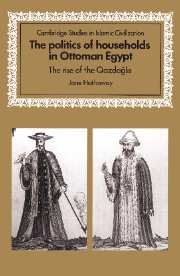Book contents
- Frontmatter
- Contents
- Note on transliteration
- List of illustrations
- List of tables
- Preface
- List of abbreviations
- Genealogical tables
- Introduction
- I The household and its place in Ottoman Egypt's history
- II Qazdağli household-building strategies
- Chapter 6 Marriage alliances and the role of women in the household
- Chapter 7 Property and commercial partnerships
- Chapter 8 The Qazdağlis and the Chief Black Eunuch
- Chapter 9 Conclusions
- Glossary
- Bibliography
- Index
Chapter 6 - Marriage alliances and the role of women in the household
Published online by Cambridge University Press: 22 September 2009
- Frontmatter
- Contents
- Note on transliteration
- List of illustrations
- List of tables
- Preface
- List of abbreviations
- Genealogical tables
- Introduction
- I The household and its place in Ottoman Egypt's history
- II Qazdağli household-building strategies
- Chapter 6 Marriage alliances and the role of women in the household
- Chapter 7 Property and commercial partnerships
- Chapter 8 The Qazdağlis and the Chief Black Eunuch
- Chapter 9 Conclusions
- Glossary
- Bibliography
- Index
Summary
Beginning at least with the tenure of 'Osman Kâhya, the Qazdağli household became a full-fledged bayt, that is, a self-sustaining household-cum-family. It included not only the household head and at least a portion of his male clients but all the women associated with the household head: daughters, female servants, nurses, and, above all, wives and concubines. These wives and concubines were not mere accessories but were critical components of the household's membership who contributed to its evolution.
It was primarily through marriage and concubinage that women achieved their leverage in Egypt's military society. Marriage to an influential grandee gave a woman access to his wealth, of which she might stand to inherit a part, particularly if the grandee had no male heirs. By the same token, marriage to the female relative or widow of an important grandee gave an aspiring bey or officer access to her dowry and her independent wealth. But in conjunction with the material wealth it conferred, such a marriage afforded the wife of an influential grandee or the husband of a well-connected woman an enhanced political and social status. Thus, an elite marriage of this type was as much an alliance or partnership as the strategic alignments and power-sharing arrangements common among male grandees. Marriage and concubinage were the elite woman's entry into the political culture of Egypt's military elite.
- Type
- Chapter
- Information
- The Politics of Households in Ottoman EgyptThe Rise of the Qazdaglis, pp. 109 - 124Publisher: Cambridge University PressPrint publication year: 1996



